
Fanqiao Wang for Quartz.
Drizzled in butter or slathered in mayo—or heaped atop 100% all-natural Angus beef,
perhaps? The question of how you like your lobster roll is no longer
the sole province of foodies, coastal New Englanders, and people who
summer in Maine. American lobster has gone mainstream, launching food
trucks from Georgia to Oregon, and debuting on menus at McDonald’s and
Shake Shack.
Unlike almost anything else that gets eaten on a
bun, Maine lobster is wild-caught—which typically makes seafood pricier.
So how has lobster gone from luxury eat to food-truck treat?'
The reason boils down to plentiful supply, plain
and simple. In fact, the state’s lobster business is the only fishery
on the planet that has endured for more than a century and yet produces
more volume and value than ever before. And not just slightly more. In
2014, Maine fishermen hauled ashore 124 million pounds of lobsters, six
times more than what they’d caught in 1984. The $456 million in value
those landings totaled was nearly 20% higher than any other year in
history, in real terms. These days, around 85% of American
lobster caught in the US is landed in Maine—more than ever before.
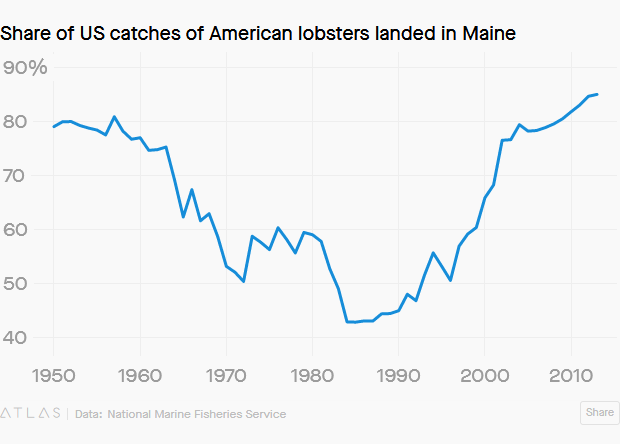
Even more remarkable than sheer volume, though, is
that this sudden sixfold surge has no clear explanation. A rise in
sea temperatures, which has sped up lobster growth and opened up new
coastal habitats for baby lobsters, is one likely reason. Another is
that by plundering cod and other big fish in the Gulf of Maine, we’ve
thinned out the predators that long kept lobster numbers in check. Both
are strong hypotheses, yet no one’s sure we really understand what’s
going on.
Even as biologists puzzle over Maine’s strange
serendipity, a more ominous mystery is emerging.
A scientist who
tracks baby lobsters reports that in the last few years their numbers
have abruptly plummeted, up and down Maine’s coast. With the number of
breeding lobsters at an all-time high, it’s unclear why the baby lobster
population would be cratering—let alone what it portends. It could
reflect a benign shift in baby lobster habitats. Or it could be that
the two-decade boom is already on its way to a bust. To form a clearer
picture why, we first need to unravel the possible causes of the current
lobster glut.
Maine Lobstermen: Early Adopter Conservationists
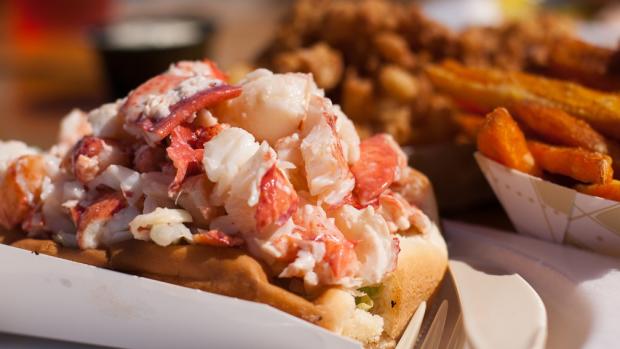
A classic Maine lobster roll. Yuri Long on Flickr, under CC-BY-2.0 (image has been cropped).
For a long time, the common wisdom was that more
than 80% of Maine lobsters of legally harvestable size are killed each
year, to be minced into bisque or slathered onto rolls. When
you’re blotting out that many of them, how do you guarantee a steady
supply of baby lobsters to keep the population growing?
Maine lobstermen approach this question differently
from almost any other fishery—and have for more than half a century.
Most fisheries forbid fishermen from bringing to shore fish under a
certain size, and limit the accumulated weight of fish caught. The idea
is to protect the juveniles so that they can propagate the species.
But the logic of this strategy defies biology—particularly in the sea, where many species tend to grow more fertile with age.
Lobsters are a case in point. When a female produces
eggs, they cling by the thousands to her underside like clusters of
tiny, dark-green berries. Egg production generally rises exponentially
with a female lobster’s size (a decent proxy for age since we still
don’t know how to tell how old lobsters are). An eight-inch female
carries half as many eggs as a 10-incher, and one-quarter the number of
eggs clinging to a foot-long female, and so on.
Rather than ignore the science, as many fisheries
do, Maine scientists and lawmakers recognized early on that protecting
big lobsters preserved the breeding stock. And not just big females.
Since they prefer even heftier mates, big male lobsters needed
protection too. Starting in 1933, lobstermen were required to throw
back any ”jumbos,” lobsters larger than 4 and 3/4 inches, measured from
eye socket to tail (these days it’s 5 inches). They also must release
“shorts”—specimens smaller than 3 1/4 inches.
Then there’s the opt-in conservationism of
“v-notching.” For half a century, Maine custom has obligated lobstermen
not just to throw back any egg-bearing females they caught; but also
first to cut out a “v” into her back tail-flipper. This mark, which her
shell will bear for decades, signals to anyone who catches her in the
future that she is fertile and must be thrown back. (The practice
officially became law a little over a decade ago.)
The upshot of these policies is that Maine
lobstermen only catch medium-sized lobsters that haven’t been caught
bearing eggs. This leaves bigger lobsters and fecund females to replace
the ones we eat.
Doomsday Prophecies
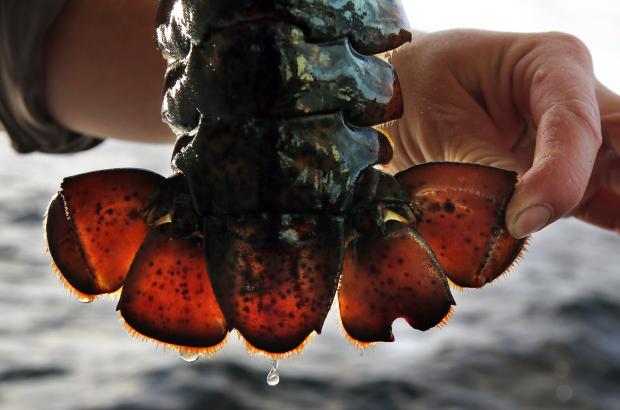
A “v-notched” female caught off Monhegan Island, Maine. AP Photo/Robert F. Bukaty.
But in the 1970s and ’80s, government scientists
doubted the benefits of this elective environmentalism. Many warned that
Maine’s lobster industry was on the brink of collapse.
“Over-exploitation certainly does exist now,” James
Thomas, the state’s leading biologist, said in 1980, as Colin Woodard
recounts in The Lobster Coast. “They’re fishing the lobster population way over the maximum that it can support.”
It’s not hard to see why he and others thought
that. For four decades, Maine lobstermen had hauled in around 20 million
pounds a year, on average. More and more fishermen were turning to
lobstering as groundfish like cod and hake were depleted—which meant
more traps in the water. In 1950, Maine lobstermen landed about 18
million pounds of lobster with around 430,000 traps. By 1975, the number
of traps had more than quadrupled to 1.8 million. Yet lobstermen caught
just 16 million pounds of lobster.
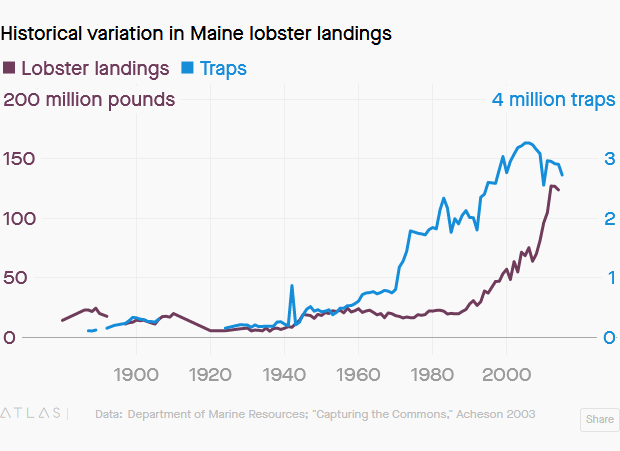
This pattern looked a lot like other fisheries on
the eve of collapse: more boats, more men, more effort—and less to show
for it.
Then, out of nowhere, in the early 1990s, lobster
landings surged. By the end of the decade, Maine’s lobstermen were
hauling ashore 50 million pounds of the big-clawed crustaceans each
year.

At the time, this was hailed as a triumph
of Maine lobstermen’s ethics and foresight. As industrial trawling
was decimating fishing stocks up and down the Atlantic seaboard, Maine’s
lobster boom seemed proof of the self-sustaining virtues of
communitarian, artisanal fishing.
It’s a story you want to believe. But lobstering
policies are only a tiny sliver of the real ecological drama underway.
By the late 2000s, it was clear that Maine’s lobster population exploded
beyond any proportions that could be explained as dividends from sound
conservation alone.

Will this bonanza continue? That would be easier to
answer if we knew for sure what was causing it. The problem is, we
don’t.
Behind Maine’s Mysterious Lobster Bonanza
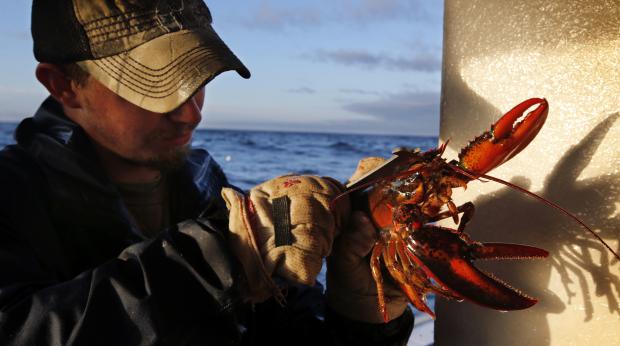
A Maine lobstermen measures his catch. AP Photo/Robert F. Bukaty.
Some obvious factors may help explain what’s going
on. The increase in traps is likely part of it, as is the improvement in
lobstering technology. But a much bigger cause is probably that the
Gulf of Maine—the shallow patch of sea between Cape Cod and the southern
tip of Nova Scotia—has been heating up faster than 99.9% of the world’s
oceans.
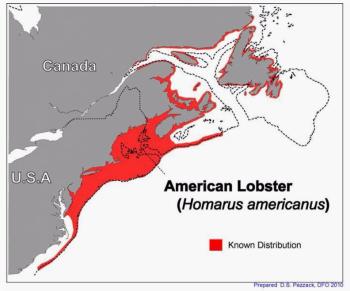
The range of the American lobster. Photo from Oceans and Fisheries Canada.
Cooled by the Labrador Current that swoops down from
the Arctic, the Gulf of Maine is much chillier than the rest of the
Atlantic coast. This is ideal for American lobsters, which generally
prefer waters between about 41°F and 64.4°F (5-18°C). Historically,
that’s kept the lobster population centered around
Maine’s southern shores.
Before 2004, average temperatures in the Gulf of
Maine had been notching up at a rate of about 1.8°F every four decades.
Then they abruptly began rising at a much steeper rate—1.8°F every four years—according to a 2013 study by a team of scholars mostly from the University of Maine.
The brisk clip of warming has pushed lobsters steadily
north. Bob Steneck, ecology professor at University of Maine, has
traced that lobstering “sweet spot” as it’s crept up the coast, first
from Casco Bay, off Portland in southern Maine, in the 1980s to where it
is today—in Stonington, about 100 miles to the northeast.
This lobster migration isn’t just about comfort.
Whether and when they pass to the next stage of their lifecycle often
depends on finding seas that are suitably temperate.
Helping Lobsters Bulk Up

A 27-pound lobster caught in 2012 by a Maine shrimp dragger. Reuters/Maine Department of Marine Resources.
In lobster land, size is survival. Big lobsters
can muscle their way into choice dens, deter predators, and—for males at
least—attract mates. The crustacean grows much faster in relatively warmer
seas. A southern New England lobster reaches harvestable size in about
five years. In the frosty waters of Canada’s Bay of Fundy, on Maine’s
eastern border, it can take from six to 10 years. In addition, females
in more temperate waters become fertile younger. Southern New England
females, for instance, reach sexual maturity when they’re around half an
inch smaller than their Bay of Fundy cousins.
Their search for warmth spurs a semi-annual lobster
migration. Icy winds that whip off the land in
winter chill inshore shallows, sending lobsters scuttling down the
coastal shelf to relatively warmer pockets. Then as the sun heats the
sea in late spring, lobsters awaken from their torpor and trek back
toward the shore to eat, mate, and bulk up.
Egg-bearing females are particularly hell-bent on
escaping the cold. During the nine to 12 months the eggs layer a
female’s underside, they require enough warmth to develop. And only when
seas are sufficiently summery—typically in June in southern New
England, and well into August the closer you get to Canada—will
the babies hatch into shrimp-like larvae.
At the mercy of currents, wind, temperatures, and
the appetites of passing fish, the vast majority of these hatchlings
don’t make it. Those lucky few that do will, within a month or two, have
grown into a tiny, fully-formed lobster about the size of a cricket.
Now big enough to swim, these larvae dive to the seafloor to settle in
rocky crannies, where they’ll hide out for the next few years, until
they’re big enough to fend for themselves.
The price of your lobster roll ultimately depends on
how many of these babies survive. It seems clear that many multiples
more little lobsters are making it into adulthood—and eventually onto
butter-sopped buns—than in the past. This probably has something to do
with the fact that, like their parents, babies also benefit from milder
Gulf of Maine temperatures.
Location, Location, Location

A baby lobster (a.k.a. “young of year”). Photo by Rick Wahle.
Even in deep summer, the waters of eastern Maine and
Canada’s Bay of Fundy have traditionally been bracingly chilly. This is
fine for adult lobsters. Their offspring have a tougher time, though.
Lab experiments suggest that in seas below about 54°F—a common enough
summer temperature in those areas—many babies struggle to survive at
all. Even among the hardier specimens, few grow big enough fast enough
to make that crucial descent to the seabed.
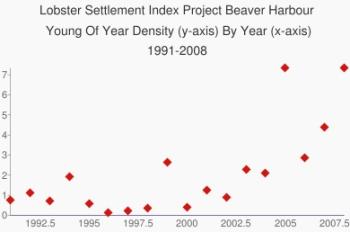
“Young of year” refers to recently settled baby lobsters.
In the early 2000s, however, the Bay of Fundy
stopped being such a baby lobster deathtrap. This discovery came
from Rick Wahle, a biologist at the University of Maine who developed a
sampling method used to count baby lobsters settled in the Bay of
Fundy’s Beaver Harbor since 1989 (the data were generated by Canadian
biologist Peter Lawton). For more than a decade, the team of divers
found fewer than one baby per square meter, on average. Then babies
started moving in. In 2005 and 2008, they found more than seven settled
baby lobsters per square meter, on average.
A similar upswing was underway on the other side of
the border, in eastern Maine, whose waters also have long been too cold
for baby lobsters. It seems likely that the warming of these typically
colder northeastern swaths of the Gulf of Maine was letting more babies
make it to the sea bottom, where they found the gravelly detritus left
by ice age glaciers.
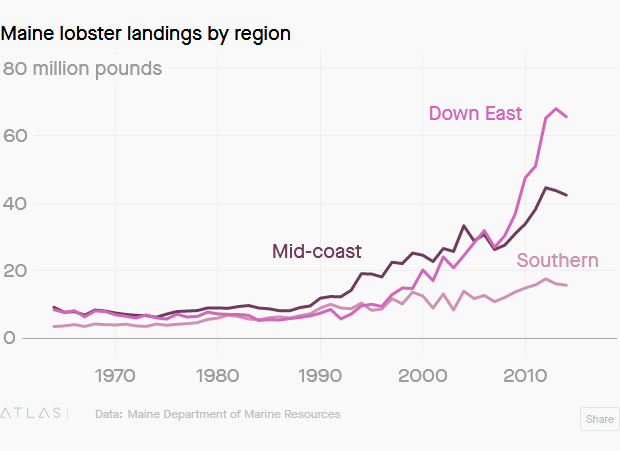
This “cobble,” as scientists call it,
makes the perfect nurseries for baby lobsters. And once settled, they
were clearly thriving. A few years after Wahle started tracking the baby
settlement uptick, lobster landings both in the Bay of Fundy and in
counties Down East, as Mainers refer to the their state’s northeastern
edge, soared.
Warming May Only Be Half the Answer
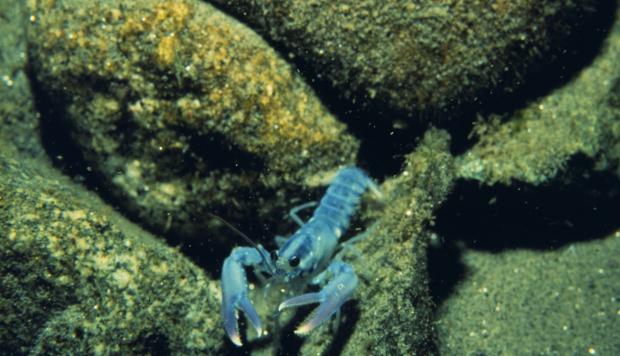
A
juvenile lobster in its preferred habitat: cobble in the Gulf of Maine.
Rick Wahle, via NOAA Photo Gallery on Flickr, CC-by-2.0. (Image has
been cropped).
Intuitively, spiking sea temperatures seem a pretty
solid explanation for much of the Maine lobster boom. More females
giving birth at smaller sizes—before they can be legally caught—not
only means more babies per each new generation. It also means more
v-notched females. Finally, thanks to warmer seas and plum new habitats,
more babies than before are surviving.
Statistics seem to bear that out: Even if you strip
away the overall trend and focus on the discrete changes, the warming
trend and the leap in lobster landings line up pretty clearly, says
Andrew Pershing, chief scientist at the Gulf of Maine Research Institute
(GMRI).
But the causal effect suggested in this relationship isn’t as obvious as it might seem.
“That [correlation] could be [a sign of] more
lobsters over the 30 year period,” says Pershing, “But year to year,
it’s also that in warm years we catch more lobsters—you basically have
this period in the summer where it’s warmer and lobsters are active and
you can catch them really quickly.”
In other words, we know that Maine lobstermen are
catching a lot more than usual, and temperature is very likely part of
the cause. But we don’t know whether there are actually more lobsters
down there, or whether the warmer water is making them easier to catch.
And then there’s this point, which appears to
undercut the thesis: The very beginnings of the great Maine lobster
surge predates the Gulf of Maine’s big temperature rise by roughly a
decade.
Man and Cod
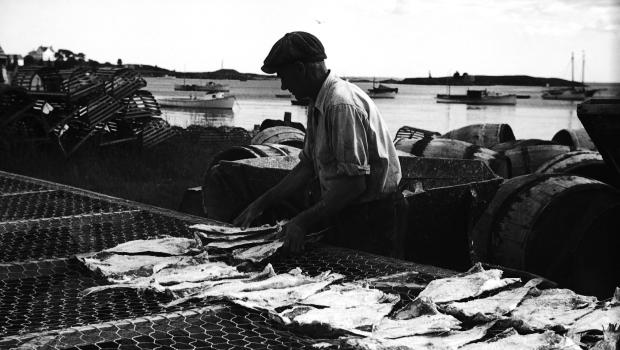
A
fisherman dries codfish in Vinalhaven, Maine, circa 1936. Flickr user
rich701, licensed under CC-BY-2.0 (image has been cropped).
The second big hypothesis behind the sudden lobster
abundance is simply that human seafood-lovers have rubbed out many of
their predators—sharks, hakes, haddock, skates, rays, and above all,
cod.
As voracious as they are massive—they can grow up to
2 meters (6.6 feet)—cod zip through the northeastern Atlantic with
their mouths agape, gulping down worms, shrimps, herring and whatever
else they can swallow. Including, of course, lobsters. Throughout much
of the last millennium,
European fleets trolled the Atlantic in search
of cod. But it wasn’t until the 1930s, when refrigerators let fishermen
catch cod with abandon, and throughout the next few decades, as
fishermen souped up their trawlers with engines, that Maine’s cod
population dwindled dangerously.
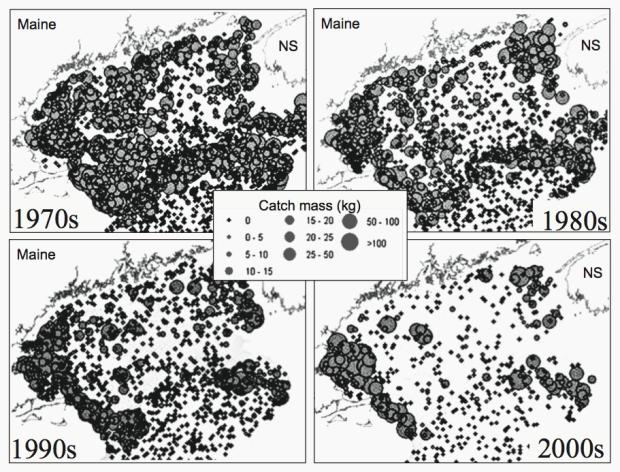
Atlantic
cod abundance. "American lobster dynamics in a brave new ocean,"
Steneck and Wahle, 2013 (modified from Sosebee and Cadrin, 2006).
This would throw any ecosystem out of whack. But
Maine’s is uniquely flimsy. One of the planet’s youngest oceans, the
North Atlantic also claims an unusually low diversity of species. The
sparse lattice of creatures in Maine’s food chain mean that even a small
change in one species’ population can throw others out of whack. This
makes for sudden booms, and just as sudden busts.
Cod sit at the very tip-top of this unusually
fragile food chain—an “apex predator,” as they’re called, that keeps
lobsters and other species in check. With cod and its fellow
apex predators obliterated, the creatures that they once ate exploded in
number. And because these smaller creatures tend to feed on cod eggs
and larvae, they may be making it hard or even impossible for cod and
other apex predators to bounce back.

There may be another factor at play, though. Heavy
fishing not only shrank cod numbers; it also shrank their
average body sizes. Research suggests the average cod size fell 20% between 1997 and 2007. A study (paywall)
by Rick Wahle and colleagues linked the lobster boom more closely to
the shrinking sizes of predator fish, than to the population decline
itself.
Normally, roving predators restrict lobsters to
tiptoeing around their rocky grottoes. With fewer—and much
wimpier—predators to worry about, lobsters can wander unprotected seabed
terrains with new abandon. Both Wahle and GRMI’s Pershing say this is
consistent with what they hear from lobstermen: They’re catching
lobsters in areas that, two decades ago, lobsters never went.
So the boom might not just be due to abundance. The
fact that lobsters are no longer stuck cowering in their craggy dens may
also be making them easier to catch.
Domesticating the American Lobster

Cheap lobsters at a tailgate party. AP Photo/Charles Krupa.
If shrinking cod tilted the ecosystem in favor of
lobsters, fishermen then unwittingly gave the crustaceans another
boost—what UMaine’s Bob Steneck calls “the domestication of the Gulf of
Maine.”
“We did it on land literally thousands of years
ago,” he says. ”Removing the predators and adding food is generally good
animal husbandry.”
In the case of Maine’s lobsters, that second part of
the domestication equation—adding food—hinges on herring. With cod and
other herring predators winnowed down in size and number, the cheaper,
smaller fish were becoming more plentiful. Americans don’t much care for
herring. But lobsters sure like it.
These days, herring is the prime bait used in
lobster traps, the few-foot-tall metal crates. Here’s a demonstration of
how one works:
Despite their names, they don’t actually “trap” at all. Using undersea cameras to spy on a trap,
scientists discovered that only 6% of lobsters that wandered into a
trap stuck around long enough to get hauled to the surface. Why do so
many lobsters mosey through and then leave? For the all-you-can-nibble
herring, naturally.

With cod gone, herring catches have boomed. AP Photo/Robert F. Bukaty.
There are close to four million traps in Maine
waters, says Steneck—each one packed with about a pound of bait per
day. ”Most of the lobsters that go into traps are undersized and can’t
be harvested,” he says. “They get a free meal.”
All those free meals boost the population—and the
industry. GMRI researchers calculated that during trapping season,
herring accounts for between a third and half of lobsters’ diets. Those in
areas with traps grow 16% faster than lobsters in areas without,
according to their research. This extra heft also adds around $40 million a year to the value of Maine’s lobster haul.
The success of this domestication process
perpetuates itself. As other fisheries founder, both Maine’s fishermen
and the state’s economy have grown increasingly reliant on its
swollen lobster haul. The lobster fishery’s total economic impact on the
state economy was $1.7 billion, as of 2012—more than 3% of Maine’s GDP that year.
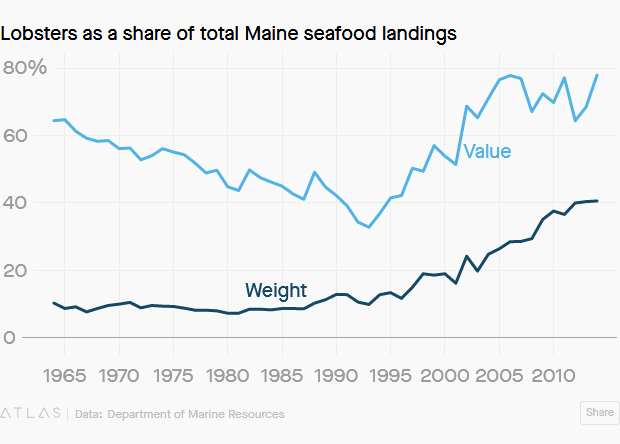
However, twilight may already falling on Maine’s
two-decade crustacean heyday. Though the contents of this season’s
lobster traps signal nothing but bounty, scientists are uncovering grim
omens from under the rocks below.
Bad News From the Baby Lobster Census
The first comes from Rick Wahle’s annual survey of
baby lobster settlement. Using scuba divers and, in deeper water,
retrievable boxes that simulate cobble, he and his team have counted
baby lobsters at more than 100 sites in Maine, Massachusetts, Rhode
Island, and Canada, a few for more than 25 years. As you’d expect, their
findings suggest that wherever baby lobsters settle in big numbers,
adults soon abound.
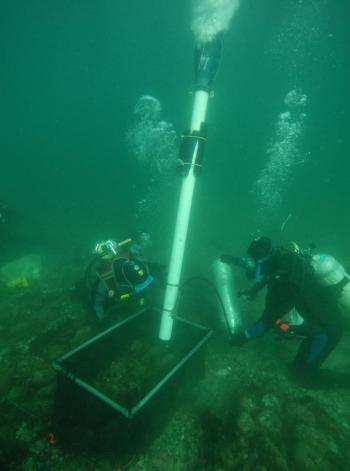
Wahle’s team surveys the Gulf of Maine’s cobble for baby lobsters. Photo by Rick Wahle.
What about the obverse, though? We’re about to find out.
In the last few years, Wahle and his team have
tracked what he calls a “widespread and deep downturn” in the number of
settled baby lobsters. Though there have been decreases at certain sites
before, the signals they’re picking up now are different.
“We’ve seen other downturns—they blink on and blink
off. But we’ve never seen all of them blink on like that.”
The slump in babies started around 2011, which means
“the next two years are going to be very telling because of that
downturn in settlement,” says Wahle.
The Case of the Missing Lobsters

Photo from Reuters/Brian Snyder.
What’s strange is that, by all reckoning, Maine’s
lobster population should be at an all-time high—which means baby
lobsters ought to be too. There are also more breeders than ever before.
The state’s lobsters are better fed, better protected, and—in the upper
Gulf of Maine, at least—they and their babies enjoy more favorable sea
temperatures than at any time in history.
“That we see such a dramatic decline in settlement
here at a time when brood stock, the spawners, are at peak levels of
abundance—there must be an environmental factor here,” says Wahle.
There are a couple of things that this could
mean. One is what Steneck—he works closely with Wahle, a former student
of his—calls the “deep water hypothesis.”
In the past, most larvae likely settled in the upper
60 feet or so of the coastal shelf, where waters were sufficiently
warm. However, cobblestone and rocky ledges extend a ways offshore in
places, perhaps 100 feet down. So as the water has gotten balmier,
they’ve been able to make their homes farther offshore—in waters that
used to be too cold for them—well beyond where Wahle and his team are
looking for them. The kids, in other words, are alright.
In another scenario, they’re not, though. Steneck
says that deeper water—where lobsters spend winter—seems to be warming
faster even than shallow areas. If this means a females’ eggs mature and
hatch while she is still far offshore, her babies could be carried out
to sea by currents into waters too cold and deep for babies to survive.
“The first scenario, if true, would be very
positive, the second one very negative—it would mean we’re going to see a
significant downturn [in landings],” says Steneck. “I just don’t think
we have a clue which one of those is correct.”
On the bright side, the first scenario jibes with
reports from fishermen who’ve been hauling up baby lobsters and juvenile
lobsters in unusually deep waters, suggesting that babies are
successfully settling there. But new research on female lobster
fecundity could tip the scale in favor of the much grimmer outlook.
Trouble with Grand Manan’s big mamas
The findings raise the possibility of another
culprit entirely: Female lobsters are suddenly producing fewer eggs.
This seems unlikely given the prime baby-making conditions created by
the warming seas. However, research (paywall)
led by Heather Koopman, a biologist at the University of North
Carolina, suggests this might be happening—and ocean warming is probably
why.
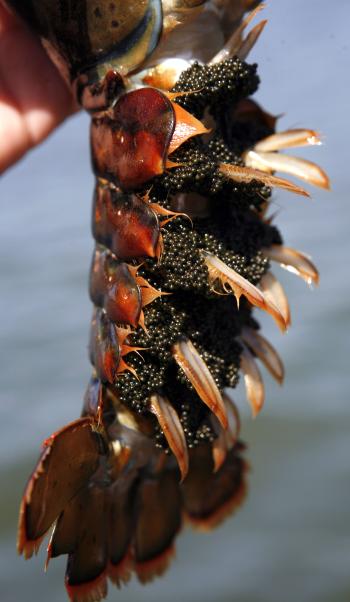
An egg-bearing female lobster caught in Harpswell, Maine. AP Photo/Pat Wellenbach.
To analyze lobster fecundity, Koopman and her team
tagged along with lobstermen working the waters near Grand Manan Island,
in Nova Scotia’s Bay of Fundy. Home to some of the biggest female
lobsters ever recorded, the island is also a spawning hotspot for the
whole region, an important source of current-carried larval emigres far
down Maine’s coast. Before tossing back each “egger” that the lobstermen
hauled up, Koopman and her team counted her eggs (or took digital
pictures so they could tally them later). Over five years, they sampled
some 1,370 lobsters, building one of the biggest collections of data on
lobster reproduction ever amassed.
The results were disconcerting. From 2008 to 2013,
the average number of eggs they counted on a lobster’s underside
declined by 30%—a drop of around 8-10% a year.
Canadian Bakin’?
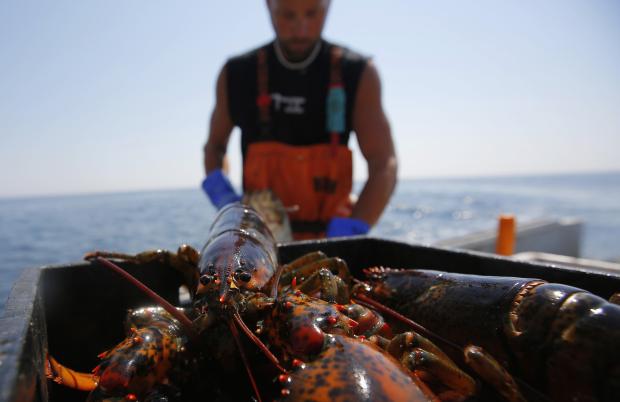
A lobster caught off Cape Elizabeth, Maine. Photo by Reuters/Brian Snyder.
What might explain this alarming drop in fecundity?
Stress from handling, pollution, disease, and lack of oxygen could in
theory be factors.
However, the most likely cause, hypothesized Koopman
and her team, is the rapid rise in water temperatures. While some
warming is obviously favorable to lobster populations, too much is
dangerous. A female lobster’s ovaries mature when temperatures
drop somewhere below the 41°F to 46.4°F range. During the five years of
the study, water temperatures never fell below 41°F, and only a few
times below 46.4°F. If Koopman and her teams’ hypothesis is right, it
also doesn’t bode well for egg production further south, in waters
already much warmer in winter than the Bay of Fundy.
Another possible factor behind the Grand Manan
Island fecundity decline could be that there simply aren’t enough big
male lobsters left to go around. Female lobsters generally prefer mating
with bigger males. That’s not as easy as it used to be though, explains
Tracy Pugh, a Massachusetts state fisheries biologist who specializes
in lobster reproduction. The more rigorous protection of eggers (Maine’s
conservation policies are the norm in Canada too) makes it highly
likely that many more females than males will avoid harvest long enough
to reach the 5-inch legal limit.
So what happens when females outnumber males, or
exceed them in size? In labs, at least, mating doesn’t always work out
so well. Guy lobsters that try to get it on with bigger
females sometimes simply fail to get the job done. Others release too
little sperm to fertilize all of the large female’s eggs. And when
females outnumber their counterparts, males sometimes can’t keep up with
the demand. However, Pugh emphasizes that lab results don’t always
reflect what happens in the wild.
Still, whatever is behind it, the fecundity decline
of Grand Manan’s big mamas could indeed explain why fewer babies are
making it to Maine cobbles than before.
The Coming Collapse?
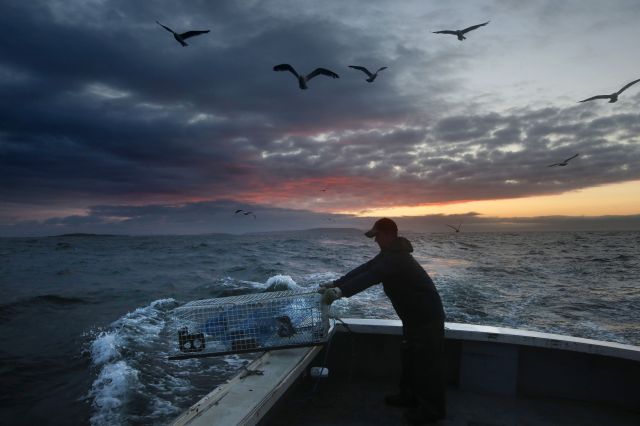
These disquieting data might just be statistical
noise—or they may foretell a reversal in the Gulf of Maine’s two-decade
lobster boom. If any fishermen can weather such a downturn, it’s Maine’s
lobstermen. Tempered by tradition, discipline, and the collective will
of generations, their practices exemplify the long game of biological
and economic sustainability that far too many other fisheries decline to
play.
As the Maine’s lobster industry’s improbable
rise reveals, no single species exists in a vacuum. Unfortunately,
conservation efforts don’t either. Two decades of lobster abundance
isn’t thanks to human mastery of ”sustainability.” The ecosystem
extremes that seem likely to have produced it—how we’ve pulled apart the
food web, heated up the sea, re-rigged the lobster population
structure—are volatile. Inevitably, nature warps again.
If this research is truly flashing a warning sign,
that warping may already be underway. For most, that means that the
local lobster roll food truck might switch back to selling kimchi tacos.
But for a state whose identity is married to the iconic big-clawed
crustacean, the stakes are much higher.
“We’re not talking about lobstermen having a bad
decade,” says UMaine’s Steneck. “We’re talking about the entire maritime
and coastal heritage of the coast of Maine.”
https://getpocket.com/explore/item/the-enigma-behind-america-s-freak-20-year-lobster-boom?utm_source=pocket-newtab
No comments:
Post a Comment